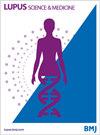深入研究昼夜节律紊乱的影响,超越明显的临床特征,通过生物学手段提高狼疮的治疗效果
IF 3.7
2区 医学
Q1 RHEUMATOLOGY
引用次数: 0
摘要
系统性红斑狼疮是一种复杂的自身免疫性疾病,临床表现具有明显的异质性1 ,其中狼疮性肾炎(LN)是其最严重的表现之一2 。尽管在了解系统性红斑狼疮发病机制方面取得了重大进展,但昼夜节律紊乱(CRD)在系统性红斑狼疮中的确切作用,尤其是它与 LN 的联系,却仍然难以捉摸。在本期的《狼疮科学与医学》(Lupus Science and Medicine)杂志上,Shen 等人发表了一项发人深省的研究,为我们揭示昼夜节律与系统性红斑狼疮严重程度之间错综复杂的相互作用提供了新的思路。作者利用先进的生物信息学和机器学习方法,对大量样本的临床特征和转录特征进行了回顾性分析。通过细致的分析,他们发现了系统性红斑狼疮患者昼夜节律通路异常的有力证据,这表明昼夜节律通路与疾病或疾病状态存在潜在联系。值得注意的是,作者的研究结果揭示了昼夜节律变化与狼疮发作之间的联系,这可能意味着昼夜节律变化在疾病演变中的作用。作者研究的核心内容是引入了复发风险评分(FRS),这是一种用于预测系统性红斑狼疮患者总体疾病进展的工具。通过严格的分析流程开发出的FRS表现出了预测疾病严重程度的良好能力,提供了一种新颖的方法...本文章由计算机程序翻译,如有差异,请以英文原文为准。
Enhancing lupus outcomes by means of biology beyond overt clinical features, exemplified in an in-depth investigation of the effects of circadian rhythm disruption
SLE is a complex autoimmune disease, characterised by a prominent clinical heterogeneity,1 with lupus nephritis (LN) standing as one of its most severe manifestations.2 Despite significant advances in understanding SLE pathogenesis, the precise role of circadian rhythm disruption (CRD) in SLE and particularly its link to LN has remained elusive. In this issue of Lupus Science and Medicine , we are presented with a thought-provoking study by Shen et al , shedding new light on the intricate interplay between circadian rhythms and SLE severity.3 What sets this study apart is its comprehensive exploration of the impact of circadian rhythms on immune function and inflammation in the context of SLE. The authors embarked on a retrospective analysis, delving into clinical characteristics and transcriptional profiles of a large number of samples using advanced bioinformatics and machine learning methodologies. Through meticulous analysis, they uncovered compelling evidence of abnormalities within the circadian pathway in patients with SLE, indicating a potential link with the disease or disease states. Notably, the authors’ findings unveil an association between CRD and lupus flares, potentially implicating a role for CRD in disease evolution. Central to the authors’ investigation is the introduction of a Flare Risk Score (FRS), a tool designed to predict overall disease progression in patients with SLE. The FRS, developed through a rigorous analytical pipeline, exhibited good ability to forecast disease severity, offering a novel approach …
求助全文
通过发布文献求助,成功后即可免费获取论文全文。
去求助
来源期刊

Lupus Science & Medicine
RHEUMATOLOGY-
CiteScore
5.30
自引率
7.70%
发文量
88
审稿时长
15 weeks
期刊介绍:
Lupus Science & Medicine is a global, peer reviewed, open access online journal that provides a central point for publication of basic, clinical, translational, and epidemiological studies of all aspects of lupus and related diseases. It is the first lupus-specific open access journal in the world and was developed in response to the need for a barrier-free forum for publication of groundbreaking studies in lupus. The journal publishes research on lupus from fields including, but not limited to: rheumatology, dermatology, nephrology, immunology, pediatrics, cardiology, hepatology, pulmonology, obstetrics and gynecology, and psychiatry.
 求助内容:
求助内容: 应助结果提醒方式:
应助结果提醒方式:


